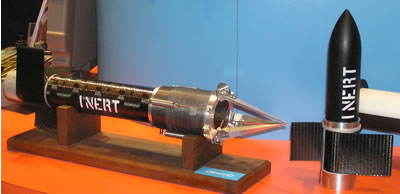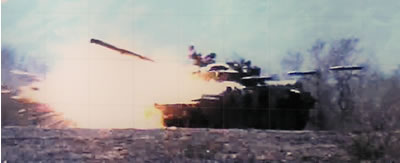Raytheon unveiled new details about the Precision Attack, Air-to-Surface Missile (PASSM), under development addressing future requirements for airborne multi-sensor precision attack weapon designed against a target set including armored vehicles and buildings, hardened bunkers and small naval targets. PASSM will use the current Hellfire rail launchers, enabling simple integration with AH-64 Apache and Longbow and Super Cobra attack helicopters and MH-60B naval helicopters. The missile will be equipped with the tri-mode seeker technology developed by Raytheon for the JCM and PAM program, enabling fully autonomous engagement as well as laser designation capability. Each missile will be fitted with a radio, establishing itself as a “node” on the battlefield network. This capability will enable it to receive targeting from multiple on-board and remote sources.
Non Line Of-Sight Launch Systems (NLOS-LS) was also displayed, as part of the NLOS weapon system which is expected to provide the core precision attack capability to the FCS BCT. NLOS is expected to “spiral out” of the FCS program in “spin-out 1” phase to accelerate its deployment with current forces. When employed with current forces NLOS-LS will be tasked by the Advanced Field Artillery Tactical Data System (AFATDS) for targeting and control. Other anti-tank weapon displayed here included the Compact Kinetic Energy Missile (CKEM) and two versions of the Medium Range Munition, extending the range of 120mm tank guns.
Urban Assault Weapons
Upgrade for the veteran TOW II missiles are underway. Raytheon is currently promoting a Bunker-Buster version of the TOW, which recently “spiraled out” of the TOW program. TOW missiles are undergoing improvements that will maintain them in service through 2025. The TOW Bunker Buster uses a fragmentation high-explosive bulk charge to breach up to 8 inches (20.3cm) of double-reinforced concrete walls and destroy fortified targets in complex urban terrain.
The Hellfire AGM-114K anti-tank version has also been modified to improve its fragmentation capability, when engaging soft targets. The Mod-K modification, pursued by Dynetics for the Aviation & Missiles R&D and Evaluation Center, included the installation of a fragmentation sleeve placed around the shaped charge, optimizing fragment lethality against a broad target set, while minimizing degradation of shaped charge performance.
Much smaller, but with potential to be most effective, is the lightweight Urban Assault Weapon (UAW) was displayed by Qinetiq. The company conducted extensive research evaluating various shoulder launched weapon concepts, designed to provide infantry troops an effective urban engagement capability. Qinetiq designed their UAW concept to be lightweight (less than 17.6 lbs (8 kg) but capable to provide multiple effects from a single munition, defeating bunkers, buildings or light armored vehicles.



















